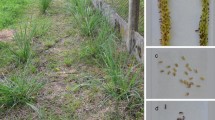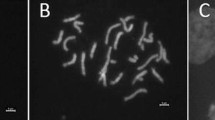Abstract
Crossing experiments in Fragaria have frequently resulted in some matroclinal progeny. These have been attributed to either accidental selfing and/or pollen contamination, or apomixis. In this study 202 carefully controlled intra and interspecific crosses in Fragaria were made. No progeny were produced from 164 interploid crosses made between diploids, hexaploids and octoploids but 38 intraploid crosses resulted in 904 F1 plants, of which 42 (4.6%) were found to be morphologically matroclinal. All matroclinal progeny subsequently studied by RAPDs were found to be hybrids and not apomicts. The absence of apomixis among matroclinal progeny in this study casts doubt on previous reports of apomixis in Fragaria. Our results showed that the complete morphological similarity of progeny to the seed parent, even in recessive characteristics, cannot therefore be taken as evidence of apomixis, and may rather indicate the heterozygosity of the pollen parent, emphasising the need to use DNA markers for confirmation of apomixis.


Similar content being viewed by others
References
Albertini EA, Porceddu F, Ferranti L, Reale G, Barcaccia B, Romano Falcinelli M (2001) Apospory and parthenogenesis may be uncoupled in Poa pratensis: a cytological investigation. Sex Plant Reprod 14:213–217
Antonius K, Nybom H (1995) Discrimination between sexual recombination and apomixis/automixis in a Rubus. Plant breeding programme. Hereditas 123:205–213
Arnholdt-Schmitt B (2000) RAPD analysis: a method to investigate aspects of the reproductive biology of Hypericum perforatum L. Theor Appl Genet 100:906–911
Asker S (1980) Gametophytic apomixis: elements and genetic regulation. Hereditas 93:277–293
Asker S, Jerling L (1992) Apomixis in plants. CRC Press, Boca Raton
Barcaccia G, Mszzucato A, Belardinelli A (1997a) Inheritance of parental genomes in progenies of Poa pratensis L. from sexual and apomictic genotypes as assessed by RAPD markers and flow cytometry. Theor Appl Genet 95:516–524
Barcaccia G, Tavoletti S, Falcinelli M (1997b) Verification of the parthenogenetic capability of unreduced eggs in an alfalfa mutant by a progeny test based on morphological and molecular markers. Plant Breeding 116:475–479
Bartish IV, Hylmo B, Nybom H (2001) RAPD analysis of interspecific relationships in presumably apomictic Cotoneaster species. Euphytica 120:273–280
Bhat V, Dwivedi KK, Khurana JP, Sopory SK (2005) Apomixis: an enigma with potential applications. Curr Sci 89:1879–1894
Bicknell RA, Koltunow AM (2004) Understanding apomixis: recent advances and remaining conundrums. Plant Cell 16:S228–S245
Carman JG (1997) Asynchronous expression of duplicate genes in angiosperms may cause apomixis, bispory, tetraspory, and polyembryony. Biol J Linn Soc 61:51–94
Carman JG, Crene CF, Rieralizarazu O (1991) Comparative histology of cell–walls during meiotic and apomeiotic megasporogenesis in 2 hexaploid Australasian Elymus species. Crop Sci 31:1527–1532
Divakaran M, Babu KN, Ravindran PN, Peter KV (2006) Interspecific hybridization in vanilla and molecular characterization of hybrids and selfed progenies using RAPD and AFLP markers. Sci Hort 108:414–422
East EM (1934) A novel type of hybridity in Fragaria. Genetics 19:167–174
Elisario PJ, Justo EM, Leitao JM (1999) Identification of mandarin hybrids by isozyme and RAPD analysis. Sci Hort 81:287–299
Garcia R, Asins MJ, Forner J (1999) Genetic analysis of apomixis in Citrus and Poncirus by molecular markers. Theor Appl Genet 99:511–518
Harris SA (2002) RAPDs in systematics- a useful methodology? In: Hollingsworth PM, Bateman RM, Gornall RJ (eds) Molecular systematics and plant evolution. Taylor and Francis, pp 211–228
Hollingsworth PM, Bateman RM, Gornall RJ (2002) Molecular systematics and plant evolution. Taylor and Francis, London and New York
Holm S, Ghatnekar L (1996) Apomixis and sexuality in hexaploid Potentilla argentea. Hereditas 125:53–60
Huff DR, Bara JM (1993) Determining genetic origins of aberrant progeny from facultative apomictic Kentucky bluegrass using a combination of flow–cytometry and silver–stained RAPD markers. Theor Appl Genet 87:201–208
Ichijima K (1926) Cytological and genetics studies on Fragaria. Genetics 11:590–601
Ichijima K (1930) Studies on the genetics of Fragaria. Z Indukt Abstamm Vererbung (Translated by British Library) 55:300–347
Koltunow AM (1993) Apomixis–embryo sacs and embryos formed without meiosis or fertilization in ovules. Plant Cell 5:1425–1437
Kroon GH, Zeilinga AE (1974) Apomixis and heterogamy in Rose rootstocks (Rosa canina L.). Euphytica 23:345–352
Li Y, Hou X, Lin L, Jing S, Deng M (2000) Abnormal pollen germination and embryo abortion in the interspecific cross, Fragaria x ananassa x F. vesca, as related to cross–incompatibility. J Jpn Soc Hortic Sci 69:84–89
Lo S, He P, Zheng P, Zhou X (2002) Inheritance of RAPD markers in an interspecific F1 hybrid of grape between Vitis quinquangularis and V. vinifera. Sci Hort 93:19–28
Maki M, Murata J (2001) Allozyme analysis of the hybrid origin of Arisaema ehimense (Araceae). Heredity 86:87–93
Mangelsdorf AJ, East EM (1927) Studies on the genetics of Fragaria. Genetics 12:307–339
Martins RL, Oliveira PE (2003) RAPD evidence for apomixis and clonal populations in Eriotheca (Bombacaceae). Plant Biol 5:338–340
Mazzucato A, Barcaccia G, Pessotti M, Falcinelli M (1995) Biochemical and molecular markers for investigating the mode of reproduction in the facultative apomict Poa pratensis L. Sex Plant Reprod 8:133–138
Millardet MA (1894) Note sur l’hybridation sans eroisement ou fausse hybridation. Mem Soc Sci Phys Nat Bordeaux 4:347–372
Nagib MAN, Vieira MA, Vieira C, Grattapaglia D (1998) A molecular and embryonic study of apomixis in cassava (Manihot esculenta Crantz). Euphytica 102:9–13
Naumova TN (1997) Apomixis in tropical fodder crops: cytological and functional aspects. Euphytica 96:93–99
Naumova TN, Willemse MTM (1995) Ultrastructural characterization of apospory in Panicum maximum. Sex Plant Reprod 8:197–204
Naumova TN, Nijs APM, Willemse MTM (1993) Quantitative analysis of aposporous parthenogenesis in Poa pratensis genotypes. Acta Bot Neerl 42:299–312
Nogler GA (1984) Gametophytic apomixis. In: Johri BM (ed) Embryology of angiosperms. Springer, Berlin Heidelberg New York
Novy RG, Kobak C, Gofreda J, Vorsa N (1994) RAPDs identify varietal misclassification and regional divergence in cranberry (Vaccinium macrocarpon (Ait.) Pursh). Theor Appl Genet 88:1004–1010
Nybom H (1996) DNA fingerprinting a useful tool in the taxonomy of apomictic plant groups. Folia Geobot Phytotaxon 31:295–304
Obata Y, Niimi Y, Nakano M, Okazaki K, Miyajima I (2000) Interspecific hybrids between Lilium nobilissimum and L. regale produced via ovules-with-placental-tissue culture. Sci Hort 84:191–204
Ortiz JPA, Pessino SC, Leblanc O, Hayward MD, Quarin CL (1997) Genetic fingerprinting for determining the mode of reproduction in Paspalum notatum, a subtropical apomictic forage grass. Theor Appl Genet 95:850–856
Ozias-Akins P (2006) Apomixis: developmental characteristics and genetics. Cr Rev Plant Sci 25:199–214
Peel MD, Carman JG, Leblanc O (1997) Megasporocyte callose in apomictic buffelgrass, Kentucky bluegrass, Pennisetum squamulatum Fresen, Tripsacum L., and weeping lovegrass. Crop Sci 37:724–732
Richards AJ (1997) Plant Breeding Systems, 2nd edition edn. Chapman and Hall, London
Richardson CW (1914) A preliminary note on the genetics of Fragaria. J Genet 3:171–178
Ritz CM, Wissemann V (2003) Male correlated non-matroclinal character inheritance in reciprocal hybrids of Rosa section Caninae (DC.) Ser. (Rosaceae). Plant Syst Evol 241:213–221
Roh MS, Lee A-K, Suh JK, Slovin J (2006) Confirmation of cross-pollination of Ardisia crenata by sequence-characterized amplified region (SCAR) markers. Sci Hort 109:361–367
Scott DH (1951) Cytological studies on polyploids derived from tetraploid Fragaria vesca and cultivated strawberries. Genetics 36:311–331
Shoyamaa Y, Kawachia F, Tanakaa H, Nakai R, Shibata T, Nishi K (1998) Genetic and alkaloid analysis of Papaver species and their F1 hybrid by RAPD, HPLC and ELISA. Fore Sci Inter 91:207–217
Staudt G (1989) The species of Fragaria, their taxonomic and geographical distribution. Acta Hortic 265:23–33
Staudt G (1999) Systematics and geographic distribution of the American strawberry species: taxonomic studies in the genus Fragaria (Rosaceae: Potentillae). University of California publications, Botany Volume 81
Tackholm G (1920) On the cytology of the genus Rosa. A preliminary note. Sven Bot Tidskr 14:300–311
Tucker MR, Paech NA, Willemse MTM, Koltunow AMG (2001) Dynamics of callose deposition and beta–1,3–glucanase expression during reproductive events in sexual and apomictic Hieracium. Planta 212:487–498
Ur–Rahman H, James DJ, Hadonou AM (1997) The use of RAPD for verifying the apomictic status of seedlings of Malus species. Theor Appl Genet 95:1080–1083
Vielle FP, Burson BL, Bashaw EC, Hussey MA (1995) Early fertilization events in the sexual and aposporous egg apparatus of Pennisetum ciliare (L) Link. Plant J 8:309–316
Werlemark G, Uggla M, Nybom H (1999) Morphological and RAPD markers show a highly skewed distribution in a pair of reciprocal crossings between hemisexual dog-rose species, Rosa sect. Caninae. Theor Appl Genet 98:557–563
Williams JGK, Kubelik AR, Livak KJ, Rafalski JA, Tingey SV (1990) DNA polymorphism amplified by arbitrary primers are useful as genetic markers. Nucleic Acids Res 18:6331–6535
Wissemann V, Hellwig FH (1997) Reproduction and hybridisation in the genus Rosa section Caninae (Ser.). Rehd Bot Acta 110:251–256
Yarnell HS (1929) Notes on the somatic chromosomes of the seven–chromosome group of Fragaria. Genetics 14:78–84
Yarnell HS (1931a) A study of certain polyploidy and aneuploid forms in Fragaria. Genetics 16:455–489
Yarnell HS (1931b) Genetics and cytological studies on Fragaria. Genetics 16:422–454
Acknowledgments
We thank K. Hummer (National Clonal Germplasm Repository, Corvallis, Oregon, USA) for providing a wide range of Fragaria material and D. Shaw for advice on methods for dormancy removing and seed germination. We also thank H. Nybom for comments on analysing RAPD patterns, M. Swaine and G. Aronne for comments on the manuscript. We thank two anonymous referees for helpful comments and additions to the manuscript.
Author information
Authors and Affiliations
Corresponding author
Rights and permissions
About this article
Cite this article
Nosrati, H., Price, A.H. & Wilcock, C.C. No evidence of apomixis in matroclinal progeny from experimental crosses in the genus Fragaria (strawberry) based on RAPDs. Euphytica 171, 193–202 (2010). https://doi.org/10.1007/s10681-009-0008-3
Received:
Accepted:
Published:
Issue Date:
DOI: https://doi.org/10.1007/s10681-009-0008-3




